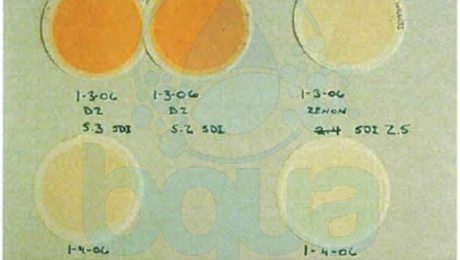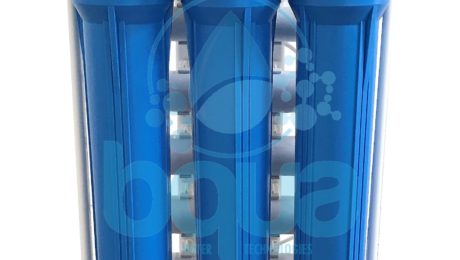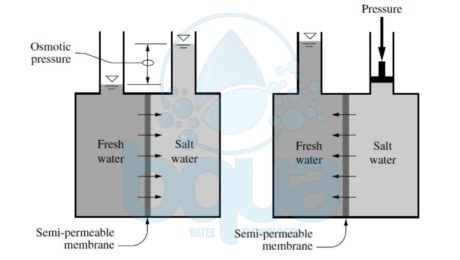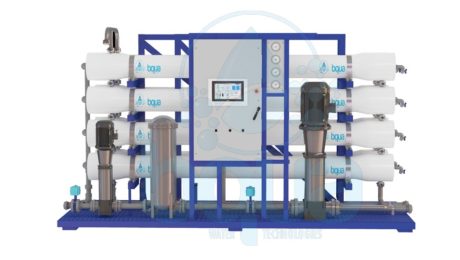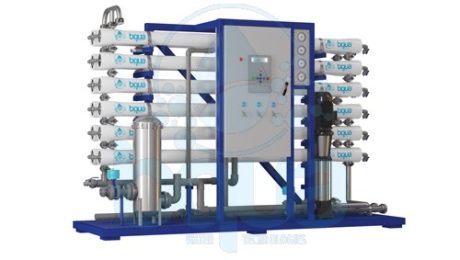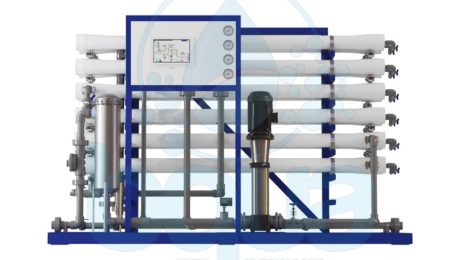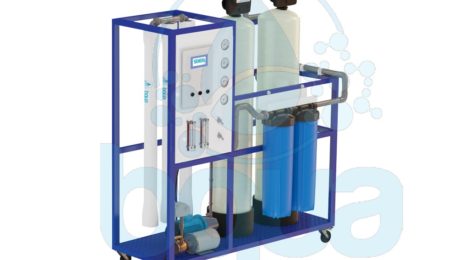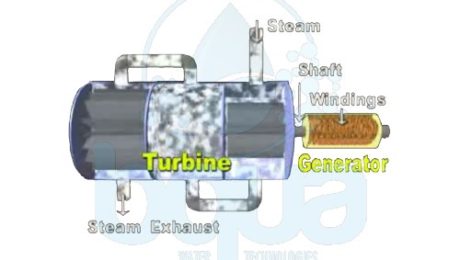What is Silt Density Index SDI Definition
The Silt Density Index (SDI) is an analytical procedure which measures the fouling potential of a sample stream, it is basically the parameter most used to determine how much pretreatment is required in designing Reverse Osmosis Systems. In reality, it is a very rough indicator of fouling potential. SDI is based upon the principal that when a filter gets plugged, less water will pass through at the same pressure. Less water passes through because of the resistance to flow caused by particles plugging the spaces in the filtering medium.
Silt Density Index SDI for Clean vs Dirty/Fouled Filter
A sample stream of the raw water is filtered through a new 0.45 micron membrane filter for fifteen minutes. The amount of time required to pass 500 ml through the filter is measured initially, (when the membrane filter is clean), and again after fifteen minutes worth of suspended material have been filtered. The reduction in flow rate (longer time to pass 500 ml at the end of the 15 minute period) is a crude measurement of the fouling potential of the stream.
SDI filter pads after testing turbidity in seawater
Most spiral wound RO membrane element manufacturers require that an RO System feed water has a fifteen minute SDI value (SDI15) of less than 5 (one manufacturer requires less than 4). An SDI15 of 5 is obtained when it takes four times longer to pass 500 ml after fifteen minutes worth of suspended solids have been deposited on the membrane than it did during the initial 500 ml. Most hollow fiber element manufacturers require that the SDI15 be less than 3.
When a membrane element supplier requires that an RO System feed water SDI15 be less than 5, this means that the feed water SDI15 must be less than 5 as it enters the Reverse Osmosis System The problem is that the particles may grow. In the case of living particles, they grow and reproduce like any organism. They add mass by accumulating nutrients from the environment. They add numbers by reproduction. Nonliving particles may grow in an Reverse Osmosis System as well. They grow by physical/chemical means called coagulation or agglomeration.
The purpose of our pretreatment equipment is to remove the relatively large particulate matter from the feed stream so it does not plug the Reverse Osmosis Systen and to limit the number of living particles entering a unit. The purpose of dispersant addition is to then keep the smaller, especially nonliving particles from agglomerating (growing larger) and remaining in the RO System.
Silt Density Index SDI and Reverse Osmosis System
Since SDI is a measurement of both living, dead, and nonliving particulate matter greater than 0.45 micron, it is a useful tool to determine the fouling potential of a feed water and how much pretreatment equipment will be required. Some general guidelines on what it will take to maintain an RO unit’s feed water SDI at less than 4 – 5 are:
| RAW WATER SDI | PRETREATMENT REQUIRED TO ACHIEVE SDI < 5 |
| Greater than 10 – 20 | Clarification, MMF, CF, +/- Dispersant (plugs in less than 5 – 10 mns) |
| 7 – 8 TO 10 – 20 | MMF (with polymer addition), CF, +/- Dispersant |
| 5 TO 7 – 8 | MMF, CF, +/- Dispersant |
| Less than 5 | CF, +/- Dispersant |
- Published in Water Treatment
What is a Reverse Osmosis System – RO System Definition
A Reverse Osmosis System is basically the application of the reverse of the Osmosis process. Where pure water is produced out of brackish or seawater by applying a pressure to the concentrated salt solution above the applied and osmotic back pressures. An Industrial Reverse Osmosis System works the same way as illustrated. Net driving pressure (NDP) forces water through the membrane. In an operating Reverse Osmosis system, feed water is pressurized by a high pressure pump. Due to Net Driving Pressure (NDP), a portion of the feed water is forced through the Reverse Osmosis semipermeable membrane.
The membrane is completely impermeable (won’t allow passage) to particles and only slightly permeable to dissolved substances. The water that passes through the membrane is called permeate. Permeate usually has very few particles in it. Unless there is a membrane defect (hole) or other problem, any particles found in the permeate were produced there (either from bacteria or equipment). Permeate is also low in dissolved substances (a small amount of dissolved solids does pass through the membrane). Permeate, therefore, is a relatively high purity water. Figure below illustrates a Reverse Osmosis System in the format we have been using so far.
Reverse Osmosis System (RO System) Illustration
Reverse Osmosis System Operation and Flushing
We know that when we pressurize the feed water and water passes through the membrane, the feed water is concentrated. If the concentration in the feed water gets high enough, the osmotic back pressure will rise to eventually give us a Net Driving Pressure (NDP) of zero and the flow will stop. In a Reverse Osmosis System, then, we must flush away the dissolved substances from the membrane surface so that the osmotic back pressure won’t keep going up. This is different from the other filters that we usually work with. Most of the filters that we have dealt with in our lives have been “full flowâ€, “accumulative†types of filters. “Full flow†means that there is one stream in (feed water) and one stream out (filtrate). “Accumulative†means that the filtered “stuff†accumulate in or on the filter.
From coffee filters, to cartridge filters, to multimedia filters, this has been the case. The feed water goes in, the filter removes the “stuff†that we want to take. When the filter gets full, we backwash or replace the filter. Membrane systems can’t be full flow or accumulative. With an RO membrane, we are filtering out ions which have an osmotic pressure. What would happen if we continue to filter out dissolved substances which produce an osmotic back pressure? Answer: The process would stop.
A Reverse Osmosis System therefore, must have a flushing flow which carries away the dissolved and suspended substances. This waste stream is called concentrate. A Reverse Osmosis System (RO System), therefore, has one stream going into it (Feed Water), and two streams coming out (Permeate & Concentrate).
The following illustration also shows a Reverse Osmosis System with a 100 gpm (22.7 m3/hr) feed water flow. The Net Driving Pressure (NDP) supplied by a high pressure pump forces around 75% of the feed water through the membrane. The water, suspended particles, and dissolved substances which don’t go through the membrane are concentrated and exit the Reverse Osmosis System as concentrate.
Reverse Osmosis System Operation Example
Reverse Osmosis System Contaminants Removal
Most water constituents retains on the feed side of the Reverse Osmosis membrane depending on their size and electric charge. While the purified water (permeate) passes through the membrane. Figure below illustrates the sizes and types of solids removed by Reverse Osmosis membranes as compared to other commonly used filtration technologies. RO membranes can reject particulate and dissolved solids of practically any size. However, they do not reject well gases, because of their small molecular size. Usually Reverse Osmosis membranes remove over 90 percent of compounds of 200 daltons (Da) or more. One Da is equal to 1.666054 × 10−24 g. In terms of physical size, RO membranes can reject well solids larger than 1 (Angstrom) Å. This means that they can remove practically all suspended solids, protozoa (i.e., Giardia and Cryptosporidium), bacteria, viruses, and other human pathogens contained in the source water. Reverse Osmosis membranes are designed to primarily reject soluble compounds (mineral ions) while retaining both particulate and dissolved solids.
BQUA Reverse Osmosis RO Membrane Contaminant Removal
The structure and configuration of Reverse Osmosis membranes is such that they cannot store and remove from their surface large amounts of suspended solids. If left in the source water, the solid particulates would accumulate and quickly plug (foul) the surface of the Reverse Osmosis membranes. Not allowing the membranes to maintain a continuous steady-state desalination process. Therefore, the suspended solids (particulates) in desalination feed water must be removed before reaching the RO membranes.
Over the past 20 years, RO membrane separation has evolved more rapidly than any other desalination technology. Mainly because of its competitive energy consumption and water production costs. Brackish Water Reverse Osmosis System (BWRO) yields the lowest overall production costs of all the desalination technologies. It is also important to note that the latest Multi-Effect Distillation MED projects built over the last 5 years have been completed at costs comparable to those for similarly sized Seawater Reverse Osmosis plants. Seawater Reverse Osmosis (SWRO) desalination – for the majority of medium and large projects – is usually is more cost competitive than thermal desalination technologies.
Example of an Industrial Brackish Water Reverse Osmosis System BWRO
- Published in Technology, Water Treatment
What is Reverse Osmosis (RO) Definition
Reverse osmosis (RO) is basially the reverse of the osmosis process. Scientists found that all that is required to reverse the process of osmosis is a suitable semipermeable membrane and applying a pressure to the concentrated salt solution above the applied and osmotic back-pressures, thereby forcing pure water through the semipermeable membrane. In other words, reverse osmosis is the process where water containing inorganic salts (minerals), suspended solids, soluble and insoluble organics, aquatic microorganisms, and dissolved gases (collectively called source water constituents or contaminants) is forced under pressure through a semipermeable membrane. Semipermeable refers to a membrane that selectively allows water to pass through it at much higher rate than the transfer rate of any constituents contained in the water. Learn more about pressure driven membranes here. If water of high salinity is separated from water of low salinity via a semipermeable membrane, a natural process of transfer of water will occur from the low-salinity side to the high-salinity side of the membrane until the salinity on both sides reaches the same concentration. This natural process of water transfer through a membrane driven by the salinity gradient occurs in every living cell; it is known as osmosis.
The hydraulic pressure applied on the membrane by the water during its transfer from the low-salinity side of the membrane to the high-salinity side is termed osmotic pressure. Osmotic pressure is a natural force similar to gravity and is proportional to the difference in concentration of total dissolved solids (TDS) on both sides of the membrane, the source water temperature, and the types of ions that form the TDS content of the source water. This pressure is independent of the type of membrane itself. In order to remove fresh (low-salinity) water from a high-salinity source water using membrane separation, the natural osmosis-driven movement of water must be reversed, i.e., the freshwater has to be transferred from the high-salinity side of the membrane to the low-salinity side. For this reversal of the natural direction of freshwater flow to occur, the high-salinity source water must be pressurized at a level higher than the naturally occurring osmotic pressure.
If the high-salinity source water is continuously pressurized at a level higher than the osmotic pressure and the pressure losses for water transfer through the membrane, a steady-state flow of freshwater from the high-salinity side of the membrane to the low-salinity side will occur, resulting in a process of salt rejection and accumulation on one side of the membrane and freshwater production on the other. This process of forced movement of water through a membrane in the opposite direction to the osmotic force driven by the salinity gradient is known as reverse osmosis (RO).
The rate of water transport through the membrane is several orders of magnitude higher than the rate of passage of salts. This significant difference between water and salt passage rates allows membrane systems to produce freshwater of very low mineral content. The applied feed water pressure counters the osmotic pressure and overcomes the pressure losses that occur when the water travels through the membrane, thereby keeping the freshwater on the low-salinity (permeate) side of the membrane until this water exits the membrane vessel.
Osmosis and Reverse Osmosis Process
The salts contained on the source water (influent) side of the membrane are retained and concentrated; they are ultimately evacuated from the membrane vessel for disposal. As a result, the RO process results in two streams—one of freshwater of low salinity (permeate) and one of feed source water of elevated salinity (concentrate, brine or retentate), as shown in the figure above. While semipermeable RO membranes reject all suspended solids, they are not an absolute barrier to dissolved solids (minerals and organics alike). Some passage of dissolved solids will accompany the passage of freshwater through the membrane. The rates of water and salt passage are the two key performance characteristics of Reverse Osmosis membranes.
Reverse Osmosis Process Drawing
- Published in Technology, Water Treatment
Industrial Brackish Water Reverse Osmosis System (BWRO)
Industrial Brackish Water Reverse Osmosis System (BWRO)
The BQIX-BW Series of industrial brackish water reverse osmosis systems is a durable, future-proof and compact Reverse Osmosis System. It is designed ideally for both city water and brackish water treatment applications. BQUA designs Reverse Osmosis Systems capable of reaching maximum and highest recovery rates depending on each water condition.
BQUA is a proud manufacturer of reverse osmosis systems. Our technical sales engineers and water treatment specialists are capable of designing and executing these systems no matter how harsh the condition or application is. BQUA will always find a solution to your tough water pollution.
  BQIX-BW Industrial Brackish Water Reverse Osmosis System BWRO
Customized Reverse Osmosis System
BQUA’s Industrial BQIX-BW Reverse Osmosis System is integrated and manufactured to exceed expectations and solve your toughest water problems. Our future-proof series is well known for its durable construction, user friendly operating system, environmental friendly materials, plug and play turnkey operation and hassle-free operation.
All BQUA RO Systems series including the BQIX-BW is customizable based on each individual water contaminants and design. Additional equipment is added if necessary based on each case to include water softener, media filter, chemical dosing, iron removal, cleaning skids, anti-scalant, etc. The BQIX-BW series has capacities ranging from as low as 200,000 GPDÂ to 900,000 GPD, with feed water TDS ranging from 1000 ppm to 10,000 ppm. These features have the capability of removing hardness, arsenic, chlorine, odor, taste, smell, color, iron, sulfur, fluoride and a lot more. BQUA industrial brackish water reverse osmosis system represents the latest technologies in the water treatment industry and is capable of removing dissolved salts, particles, organics, minerals, solids and other contaminants from water with a molecular weight greater than 150-250 Dalton. We partner with major market players in the field of water treatment and only use top quality brands and the most reputable manufacturers; Pentair, Dow, Hydrodex and Siemens.
Industrial Brackish Water Reverse Osmosis Product Specifications
| Operation Specifications | ||
|
|
|
BQUA BQIX-BW Series Product Specifications by model number
| Industrial Brackish Reverse Osmosis System BQIX-BW Series | ||||||
|---|---|---|---|---|---|---|
| Model Number | Permeate Flow Rate | Membranes | Motor Rating at 1,000 ppm | |||
| GPD | M3/Day | Size | Qty. | 60Hz (hp) | 50Hz (kw) | |
| BQ200K-BW | 200,000 | 758 | 8″ X 40″ | 28 | 30 | 22 |
| BQ225K-BW | 225,000 | 852 | 8″ X 40″ | 30 | 30 | 22 |
| BQ270K-BW | 270,000 | 1,023 | 8″ X 40″ | 36 | 40 | 30 |
| BQ320K-BW | 320,000 | 1,212 | 8″ X 40″ | 42 | 40 | 30 |
| BQ360K-BW | 360,000 | 1,364 | 8″ X 40″ | 48 | 50 | 37 |
| BQ410K-BW | 410,000 | 1,553 | 8″ X 40″ | 54 | 60 | 37 |
| BQ450K-BW | 450,000 | 1,705 | 8″ X 40″ | 60 | 60 | 45 |
| BQ500K-BW | 500,000 | 1,894 | 8″ X 40″ | 66 | 60 | 45 |
| BQ550K-BW | 550,000 | 2,083 | 8″ X 40″ | 77 | 75 | 45 |
| BQ600K-BW | 600,000 | 2,273 | 8″ X 40″ | 91 | 100 | 55 |
| BQ700K-BW | 700,000 | 2,652 | 8″ X 40″ | 98 | 100 | 75 |
| BQ800K-BW | 800,000 | 3,030 | 8″ X 40″ | 112 | 2 X 60 | 2 X 37 |
| BQ900K-BW | 900,000 | 3,409 | 8″ X 40″ | 126 | 2 X 60 | 2 X 37 |
| For more information, please feel free to ask a BQUA specialist | ||||||
Standard and Available Features:
| Standard Features: | Available Options: |
|
|
Light Industrial Brackish Water Reverse Osmosis System (BWRO)
Light Industrial Brackish Water Reverse Osmosis System (BWRO)
The BQLIX-BW Series of light industrial brackish water reverse osmosis systems is a durable, future-proof and compact Reverse Osmosis System. It is designed ideally for both city water and brackish water treatment applications. BQUA designs Reverse Osmosis Systems capable of reaching maximum and highest recovery rates depending on each water condition.
BQUA is a proud manufacturer of reverse osmosis systems. Our technical sales engineers and water treatment specialists are capable of designing and executing these systems no matter how harsh the condition or application is. BQUA will always find a solution to your tough water pollution.
BQUA BQLIX-BW Light Industrial Reverse Osmosis Water Treatment System
Customized Reverse Osmosis System
BQUA’s Light Industrial BQLIX-BW Reverse Osmosis System is integrated and manufactured to exceed expectations and solve your toughest water problems. Our future-proof series is well known for its durable construction, user friendly operating system, environmental friendly materials, plug and play turnkey operation and hassle-free operation.
All BQUA RO Systems series including the BQLIX-BW is customizable based on each individual water contaminants and design. Additional equipment is added if necessary based on each case to include water softener, media filter, chemical dosing, iron remval, cleaning skids, anti-scalant, etc. The BQLIX-BW series has capacities ranging from as low as 28,000 GPDÂ to 173,000 GPD, with feed water TDS ranging from 1000 ppm to 10,000 ppm. These features have the capability of removing hardness, arsenic, chlorine, odor, taste, smell, color, iron, sulfur, fluoride and a lot more. BQUA light industrial brackish water reverse osmosis system represents the latest technologies in the water treatment industry and is capable of removing dissolved salts, particles, organics, minerals, solids and other contaminants from water with a molecular weight greater than 150-250 Dalton. We partner with major market players in the field of water treatment and only use top quality brands and the most reputable manufacturers; Pentair, Dow, Hydrodex and Siemens.
Light Industrial Brackish Water Reverse Osmosis Product Specifications
| Operation Specifications | ||
|
|
|
BQUA BQLIX-BW Series Product Specifications by model number
| Light Industrial Brackish Reverse Osmosis System BQLIX-BW Series | ||||||
|---|---|---|---|---|---|---|
| Model Number | Permeate Flow Rate | Membranes | Motor Rating at 1,000 ppm | |||
| GPD | M3/Day | Size | Qty. | 60Hz (hp) | 50Hz (kw) | |
| BQ28K-BW | 28,000 | 109 | 8″ X 40″ | 4 | 5 | 4 |
| BQ36K-BW | 36,000 | 136 | 8″ X 40″ | 5 | 7.5 | 4 |
| BQ43K-BW | 43,000 | 164 | 8″ X 40″ | 6 | 7.5 | 5.5 |
| BQ57K-BW | 57,000 | 218 | 8″ X 40″ | 8 | 7.5 | 7.5 |
| BQ72K-BW | 72,000 | 273 | 8″ X 40″ | 10 | 10 | 7.5 |
| BQ87K-BW | 87,000 | 327 | 8″ X 40″ | 12 | 15 | 11 |
| BQ108K-BW | 108,000 | 409 | 8″ X 40″ | 15 | 20 | 15 |
| BQ130K-BW | 130,000 | 491 | 8″ X 40″ | 18 | 20 | 15 |
| BQ144K-BW | 144,000 | 545 | 8″ X 40″ | 20 | 20 | 15 |
| BQ173K-BW | 173,000 | 655 | 8″ X 40″ | 24 | 20 | 18.5 |
| For more information, please feel free to ask a BQUA specialist | ||||||
Standard and Available Features:
| Standard Features: | Available Options: |
|
|
Commercial Brackish Water Reverse Osmosis System (BWRO)
Commercial Brackish Water Reverse Osmosis System (BWRO)
The BQCX-BW Series of commercial brackish water reverse osmosis systems is a durable, future-proof and compact Reverse Osmosis System designed ideally for tap and brackish water treatment applications. BQUA designs RO systems that are capable of reaching maximum and highest recovery rates depending on the water condition.
BQUA is a proud supplier of standard and customized reverse osmosis systems. Our technical sales engineers and water treatment specialists are capable of designing these systems no matter how harsh was the condition or application. BQUA will always find a solution to your tough water pollution.
BQUA BQCX Series of Commercial Brackish Water Reverse Osmosis System
Customized Reverse Osmosis System
BQUA’s Commercial BQCX-BW Reverse Osmosis System is integrated and manufactured to exceed expectations and solve your toughest water problems. Our future-proof series is well known for its durable construction, user friendly operating system, environmental friendly materials, plug and play turnkey operation and hassle-free operation.
All BQUA RO series including the BQCX-BW is customizable based on each individual water contaminants and design. Additional equipment is added if necessary based on each case to include water softener, media filter, chemical dosing, iron remval, cleaning skids, anti-scalant, etc. The BQCX-BW series has capacities ranging from as low as 13,000 GPDÂ to 32,000 GPD, with feed water TDS ranging from 1000 ppm to 10,000 ppm. These features have the capability of removing hardness, arsenic, chlorine, odor, taste, smell, color, iron, sulfur, fluoride and a lot more. BQUA commercial brackish water reverse osmosis system represents the latest technologies in the water treatment industry and is capable of removing dissolved salts, particles, organics, minerals, solids and other contaminants from water with a molecular weight greater than 150-250 Dalton. We partner with major market players in the field of water treatment and only use top quality brands and the most reputable manufacturers; Pentair, Dow, Hydrodex and Siemens.
Commercial Brackish Water Reverse Osmosis Product Specifications
| Operation Specifications | ||
|
|
|
BQUA BQCX-BW Series Product Specifications by model number
| Commercial Brackish Reverse Osmosis System BQCX-BW Series | ||||||
|---|---|---|---|---|---|---|
| Model Number | Permeate Flow Rate | Membranes | Motor Rating at 1,000 ppm | |||
| GPD | M3/Day | Size | Qty. | 60Hz (hp) | 50Hz (kw) | |
| BQ13K-BW | 13,000 | 50 | 4″ X 40″ | 9 | 3 | 2.2 |
| BQ15K-BW | 15,000 | 57 | 4″ X 40″ | 10 | 5 | 2.2 |
| BQ18K-BW | 18,000 | 68 | 4″ X 40″ | 12 | 5 | 3 |
| BQ22K-BW | 22,000 | 85 | 4″ X 40″ | 15 | 5 | 3 |
| BQ24K-BW | 24,000 | 91 | 4″ X 40″ | 16 | 5 | 3 |
| BQ27K-BW | 27,000 | 102 | 4″ X 40″ | 18 | 5 | 3 |
| BQ32K-BW | 32,000 | 121 | 4″ X 40″ | 21 | 5 | 4 |
| For more information, please feel free to ask a BQUA specialist | ||||||
Standard and Available Features:
| Standard Features: | Available Options: |
|
|
Light Commercial Brackish Water Reverse Osmosis System (BWRO)
Light Commercial Brackish Water Reverse Osmosis System (BWRO)
The BQLCX-BW Series of light commercial brackish water reverse osmosis systems is a durable, future-proof and compact Reverse Osmosis System designed ideally for tap and brackish water treatment applications. Even our small compact RO systems are capable of reaching high recovery rates depending on the water condition.
BQUA is a proud supplier of standard and customized reverse osmosis systems. Our technical sales engineers and water treatment specialists are capable of designing these systems no matter how harsh was the condition or application. BQUA will always find a solution to your tough water pollution.
BQUA BQLCX-BW: Light Commercial Brackish Water Reverse Osmosis System BWRO
BQUA reverse osmosis system for commercial drinking water treatment application
BQUA Reverse Osmosis System RO System – Side View
BQUA Commercial Reverse Osmosis Water Treatment System – Rear View
Customized Reverse Osmosis System
BQUA’s Light Commercial BQLCX-BW Reverse Osmosis System is integrated and manufactured to exceed expectations and solve your toughest water problems. Our future-proof series is well known for its durable construction, user friendly operating system, environmental friendly materials, plug and play turnkey operation and hassle-free operation.
All BQUA RO series including the BQLCX-BW is customizable based on each individual water contaminants and design. Additional equipment is added if necessary based on each case to include water softener, media filter, chemical dosing, iron remval, cleaning skids, anti-scalant, etc. The BQLCX-BW series has capacities ranging from as low as 600 GPDÂ to 15,000 GPD, with feed water TDS ranging from 1000 ppm to 10,000 ppm. These features have the capability of removing hardness, arsenic, chlorine, odor, taste, smell, color, iron, sulfur, fluoride and a lot more. BQUA light commercial brackish water reverse osmosis system represents the latest technologies in the water treatment industry and is capable of removing dissolved salts, particles, organics, minerals, solids and other contaminants from water with a molecular weight greater than 150-250 Dalton. We partner with major market players in the field of water treatment and only use top quality brands and the most reputable manufacturers; Pentair, Dow, Hydrodex and Siemens.
Light Commercial Brackish Water Reverse Osmosis Product Specifications
| Operation Specifications | ||
|
|
|
BQUA BQLCX-BW Series Product Specifications by model number
| Light Commercial Brackish Reverse Osmosis System BQLCX-BW Series | ||||||
|---|---|---|---|---|---|---|
| Model Number | Permeate Flow Rate | Membranes | Motor Rating at 1,000 ppm | |||
| GPD | M3/Day | Size | Qty. | 60Hz (hp) | 50Hz (kw) | |
| BQ600-BW | 600 | 2 | 2.5″ X 40″ | 1 | 1/2 | 1/2 |
| BQ1200-BW | 1,200 | 5 | 2.5″ X 40″ | 2 | 1/2 | 1/2 |
| BQ1800-BW | 1,800 | 7 | 2.5″ X 40″ | 3 | 3/4 | 3/4 |
| BQ1500-BW | 1,500 | 6 | 4″ X 40″ | 1 | 1 | 1 |
| BQ3000-BW | 3,000 | 11 | 4″ X 40″ | 2 | 1 | 1 |
| BQ4500-BW | 4,500 | 17 | 4″ X 40″ | 3 | 1.5 | 1.5 |
| BQ6000-BW | 6,000 | 23 | 4″ X 40″ | 4 | 1.5 | 1.5 |
| BQ7500-BW | 7,500 | 28 | 4″ X 40″ | 5 | 2 | 2 |
| BQ9000-BW | 9,000 | 34 | 4″ X 40″ | 6 | 2 | 2 |
| BQ12K-BW | 12,000 | 45 | 4″ X 40″ | 8 | 3 | 3 |
| BQ15K-BW | 15,000 | 57 | 4″ X 40″ | 10 | 3 | 3 |
| For more information, please feel free to ask a BQUA specialist | ||||||
Standard and Available Features:
| Standard Features: | Available Options: |
|
|
Water Treatment Power Plant:
There are many power generation plants around the world. It takes a lot of cooling water and it takes a lot of high purity water created in sophisticated water treatment power generation system to produce electricity. We need to know how electricity is made in order to understand the water treatment for boiler feed water properties and also cooling tower feed water.
We’ve all seen electric motors, electricity goes into the winding of the motor and causes the shaft to turn. Power generation is the reverse of the motor, if a shaft is turned within the winding, electricity exits the windings.
electricity causes shaft in motor to turn
In a power generation plant, windings section is called the generator. The shaft inside of the windings is attached to a shaft inside of the turbine section. And within the turbine are sets of fins. Steam enters the turbine and passes through the fins causing the shaft to turn. This results in the production of electricity from the generator.
water treatment power plant electricity generation
The steam must be very high purity. If the steam has contaminants like Silica present, they can scale out on the surface of the blades causing an imbalance that will eventually destroy the turbine. The high purity steam is produced in the boiler. When liquid water is heated sufficiently, steam is produced. A boiler is an efficient way of boiling water and producing steam. This is why boiler water treatment along with cooling tower water treatment are very important and critical in the water treatment power generation.
The most commonly used water treatment power plant scheme for treating boiler feed water is by using a reverse osmosis system. Along with a mixed bed resin, we guarantee a complete removal of any contaminants that can cause scaling inside the turbine. Visit BQUA water treatment products page to learn more about our reverse osmosis system and its capabilities.
- Published in Water Treatment
Welcome to BQUA’s Water Treatment Blog
We are going to share the latest information and news regarding the top of the line applied water treatment technologies and many other water related topics. Posts will also focus on commercial and industrial Reverse Osmosis, seawater desalination, water treatment solutions, and other various water purification systems and applications.
Keep an eye on our Reverse Osmosis Water Treatment Blog to keep yourself and your company updated with the latest applied water technologies in the science of purification and treatment of water.
- Published in Water Treatment

